Director: Charles Barton
Release Date: 1948
Contains spoilers
An incorrectly titled film, if I’m to be picky, as it is Frankenstein’s Monster and not Frankenstein - this is a real monster mash with several of the great Universal monsters. We have, of course, Frankenstein’s Monster (Glenn Strange), the Wolf Man (Lon Chaney Jr.), a brief cameo at the end by the invisible man (voiced by Vincent Price) and, of course, Dracula (Bela Lugosi).
 This was only the second time that Lugosi played Dracula and it would be the last, so it is quite astounding that having played Dracula only twice he should have become so associated with the character – it just shows the power of his performance in the role. In fact Lugosi wasn’t the first choice for the role in this movie, Universal Studios actually thought him dead!
This was only the second time that Lugosi played Dracula and it would be the last, so it is quite astounding that having played Dracula only twice he should have become so associated with the character – it just shows the power of his performance in the role. In fact Lugosi wasn’t the first choice for the role in this movie, Universal Studios actually thought him dead!
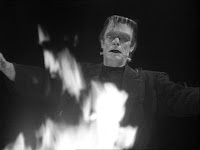 Of course, being an Abbott and Costello film this is a comedy but one of the strengths of this film, to me, is that the comedy is centered firmly on the comedians and the monsters are treated with respect and played straight. That’s not to say that they are not involved in the jokes but they are certainly not the butt of them – that honour tends to fall to Costello.
Of course, being an Abbott and Costello film this is a comedy but one of the strengths of this film, to me, is that the comedy is centered firmly on the comedians and the monsters are treated with respect and played straight. That’s not to say that they are not involved in the jokes but they are certainly not the butt of them – that honour tends to fall to Costello.
The film opens with an animated title sequence (we will return to the subject of animation later) and then we move to London, with an opening scene lifted from Frankenstein Meets the Wolf Man (1943).
We see Larry Talbot, the Wolf Man’s human persona, in a hotel room trying to place a call to a Florida baggage company. Unfortunately for Talbot the company is staffed by Chick Young (Bud Abbott) and Wilbur Grey (Lou Costello).
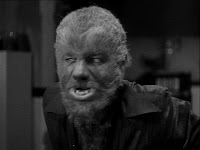 Before they receive the call we get some slapstick with baggage and then meet Wilbur’s girl, Sandra (Lénore Aubert). Wilbur answers Talbot’s call, who tells him that they will have received two crates for McDougal’s House of Horrors. He is flying to America and they mustn’t deliver them before he arrives. Wilbur thinks Talbot must by McDougal but, in London, the moon comes out and he changes – Wilbur wonders why his caller's dog is now on the phone as he hears the sounds of the Wolf Man’s rage.
Before they receive the call we get some slapstick with baggage and then meet Wilbur’s girl, Sandra (Lénore Aubert). Wilbur answers Talbot’s call, who tells him that they will have received two crates for McDougal’s House of Horrors. He is flying to America and they mustn’t deliver them before he arrives. Wilbur thinks Talbot must by McDougal but, in London, the moon comes out and he changes – Wilbur wonders why his caller's dog is now on the phone as he hears the sounds of the Wolf Man’s rage.
McDougal is actually at the front desk and wants his crates delivered (for overtime, Wilbur points out, “because I'm a union man and I work only sixteen hours a day.” McDougal retorts that, “A union man only works eight hours a day.” Wilbur explains “I belong to two unions.”) The crates contain the dormant body of Frankenstein’s monster and the coffin and ‘remains’ of Count Dracula.
 Wilbur and Chick deliver and unpack the crates at the spooky waxworks and we have a series of gags involving moving candles and Dracula leaving (and getting back into) his coffin, the jokes centered on Wilbur’s reaction plus Chick’s disbelief. There is a marvelous moment where Dracula enters full on eye mojo mode with Wilbur and, given it is Lugosi, we get the full hand gestures as well – great stuff.
Wilbur and Chick deliver and unpack the crates at the spooky waxworks and we have a series of gags involving moving candles and Dracula leaving (and getting back into) his coffin, the jokes centered on Wilbur’s reaction plus Chick’s disbelief. There is a marvelous moment where Dracula enters full on eye mojo mode with Wilbur and, given it is Lugosi, we get the full hand gestures as well – great stuff.
Whilst Wilbur is hypnotized Lugosi revives the monster (by topping up electricity from his signet ring to the monster’s bolts and eyes) and they hide away so, when McDougal arrives with his insurance assessor they are nowhere to be seen. It is assumed that Chick and Wilbur have stolen his exhibits and they are thrown into jail.
Dracula takes the Monster to a lake castle where he meets Sandra, who is actually Dr. Sandra Mornay – a mad scientist whom Dracula has recruited to help him revive the monster fully. He does not wish to make the same mistake that Frankenstein made, he wants the Monster to have a brain weak and malleable and Mornay has decided to transplant Wilbur’s brain into the creature, hence posing as his girlfriend.
Wilbur and Chick are released on bail provided by Joan Raymond (Jane Randolph) who makes out that she has fallen in love with Wilbur but is actually an insurance assessor on the trail of the missing exhibits and believes she can get to them through Wilbur and, of course,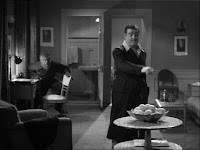 Talbot arrives as he wants to destroy Dracula and the Monster. Chick doesn’t believe Wilbur’s tales of the vampire and the monster. Throw in straight laced researcher Dr Stevens (Charles Bradstreet) and you have a recipe for chaotic comedy that leads, eventually, to the inevitable fight between the monsters. One great thing about the film is that we have a real motivation/plot for all the monsters to be in the place at the same time.
Talbot arrives as he wants to destroy Dracula and the Monster. Chick doesn’t believe Wilbur’s tales of the vampire and the monster. Throw in straight laced researcher Dr Stevens (Charles Bradstreet) and you have a recipe for chaotic comedy that leads, eventually, to the inevitable fight between the monsters. One great thing about the film is that we have a real motivation/plot for all the monsters to be in the place at the same time.
The special effects are pretty good, given when it was made, and I must point out the bats. There are model bats used but, often, Dracula as a bat and, always, Dracula morphing from bat to human shape are done in animation. As strange as this sounds it works well and, to a degree, they should have dropped the model bats all together. Perhaps it is because this is a comedy that the use of animation doesn’t jar, or perhaps because, though it is clearly animation, it is done well. If nothing else it must make it one of the earliest examples of a bat morphing into the vampire in a film in full view - though I stand to be corrected.
 Mornay starts getting cold feet and so Dracula uses eye mojo on her, breaks her will and then bites her. This would have been a great scene other than the fact that when he goes for the bite he is clearly visible in a mirror. Remember, Universal established a no reflection rule back in 1931’s Dracula.
Mornay starts getting cold feet and so Dracula uses eye mojo on her, breaks her will and then bites her. This would have been a great scene other than the fact that when he goes for the bite he is clearly visible in a mirror. Remember, Universal established a no reflection rule back in 1931’s Dracula.
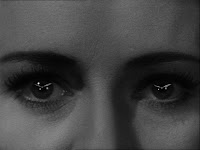 However, when Mornay – who seems to become at least part vampire – tries to dominate Wilbur and forces him to look in her eyes we have the excellent image of bats in her pupils. This worked very nicely indeed and little touches like this can really make a film.
However, when Mornay – who seems to become at least part vampire – tries to dominate Wilbur and forces him to look in her eyes we have the excellent image of bats in her pupils. This worked very nicely indeed and little touches like this can really make a film.
Comedy wise, I must admit I am not that familiar with the work of Abbott and Costello but I found this to be consistently amusing. There was a great scene where Wilbur is searching the castle and ends up sat on the Monster’s lap by accident. According to imdb’s trivia this scene had to be shot many times as Costello adlibbed so much that Glenn Strange kept cracking up – if only this had been shot in a time where such outtakes were religiously kept for DVD extras!
There was a great scene where Wilbur is searching the castle and ends up sat on the Monster’s lap by accident. According to imdb’s trivia this scene had to be shot many times as Costello adlibbed so much that Glenn Strange kept cracking up – if only this had been shot in a time where such outtakes were religiously kept for DVD extras!
Yet, to me the real joy, above and beyond the comedy, were the monsters and, more so, seeing Lugosi reprising the role of Dracula. Lugosi is fantastic, playing the role with gusto and, given some of the poor films he made in his career, it is fantastic to see him at the top of his game in a role that was really made for him. It should be noted that in one scene the Monster is played by Lon Chaney Jr. as Strange had broken his ankle. The addition of the invisible man is pure cameo, lasts only a line, but it was great to hear Price’s marvelous voice.
Fans of monster movies and, specifically, Lugosi should really want this one. A gothic castle, a waxwork museum, the Wolf Man, Frankenstein and Dracula – can you ask for more? Possibly only the inclusion of Karloff was missing but he refused the role – although he did publicity work for the film. 7 out of 10.
The imdb page is here.
Release Date: 1948
Contains spoilers
An incorrectly titled film, if I’m to be picky, as it is Frankenstein’s Monster and not Frankenstein - this is a real monster mash with several of the great Universal monsters. We have, of course, Frankenstein’s Monster (Glenn Strange), the Wolf Man (Lon Chaney Jr.), a brief cameo at the end by the invisible man (voiced by Vincent Price) and, of course, Dracula (Bela Lugosi).
 This was only the second time that Lugosi played Dracula and it would be the last, so it is quite astounding that having played Dracula only twice he should have become so associated with the character – it just shows the power of his performance in the role. In fact Lugosi wasn’t the first choice for the role in this movie, Universal Studios actually thought him dead!
This was only the second time that Lugosi played Dracula and it would be the last, so it is quite astounding that having played Dracula only twice he should have become so associated with the character – it just shows the power of his performance in the role. In fact Lugosi wasn’t the first choice for the role in this movie, Universal Studios actually thought him dead! Of course, being an Abbott and Costello film this is a comedy but one of the strengths of this film, to me, is that the comedy is centered firmly on the comedians and the monsters are treated with respect and played straight. That’s not to say that they are not involved in the jokes but they are certainly not the butt of them – that honour tends to fall to Costello.
Of course, being an Abbott and Costello film this is a comedy but one of the strengths of this film, to me, is that the comedy is centered firmly on the comedians and the monsters are treated with respect and played straight. That’s not to say that they are not involved in the jokes but they are certainly not the butt of them – that honour tends to fall to Costello.The film opens with an animated title sequence (we will return to the subject of animation later) and then we move to London, with an opening scene lifted from Frankenstein Meets the Wolf Man (1943).
We see Larry Talbot, the Wolf Man’s human persona, in a hotel room trying to place a call to a Florida baggage company. Unfortunately for Talbot the company is staffed by Chick Young (Bud Abbott) and Wilbur Grey (Lou Costello).
 Before they receive the call we get some slapstick with baggage and then meet Wilbur’s girl, Sandra (Lénore Aubert). Wilbur answers Talbot’s call, who tells him that they will have received two crates for McDougal’s House of Horrors. He is flying to America and they mustn’t deliver them before he arrives. Wilbur thinks Talbot must by McDougal but, in London, the moon comes out and he changes – Wilbur wonders why his caller's dog is now on the phone as he hears the sounds of the Wolf Man’s rage.
Before they receive the call we get some slapstick with baggage and then meet Wilbur’s girl, Sandra (Lénore Aubert). Wilbur answers Talbot’s call, who tells him that they will have received two crates for McDougal’s House of Horrors. He is flying to America and they mustn’t deliver them before he arrives. Wilbur thinks Talbot must by McDougal but, in London, the moon comes out and he changes – Wilbur wonders why his caller's dog is now on the phone as he hears the sounds of the Wolf Man’s rage.McDougal is actually at the front desk and wants his crates delivered (for overtime, Wilbur points out, “because I'm a union man and I work only sixteen hours a day.” McDougal retorts that, “A union man only works eight hours a day.” Wilbur explains “I belong to two unions.”) The crates contain the dormant body of Frankenstein’s monster and the coffin and ‘remains’ of Count Dracula.
 Wilbur and Chick deliver and unpack the crates at the spooky waxworks and we have a series of gags involving moving candles and Dracula leaving (and getting back into) his coffin, the jokes centered on Wilbur’s reaction plus Chick’s disbelief. There is a marvelous moment where Dracula enters full on eye mojo mode with Wilbur and, given it is Lugosi, we get the full hand gestures as well – great stuff.
Wilbur and Chick deliver and unpack the crates at the spooky waxworks and we have a series of gags involving moving candles and Dracula leaving (and getting back into) his coffin, the jokes centered on Wilbur’s reaction plus Chick’s disbelief. There is a marvelous moment where Dracula enters full on eye mojo mode with Wilbur and, given it is Lugosi, we get the full hand gestures as well – great stuff.Whilst Wilbur is hypnotized Lugosi revives the monster (by topping up electricity from his signet ring to the monster’s bolts and eyes) and they hide away so, when McDougal arrives with his insurance assessor they are nowhere to be seen. It is assumed that Chick and Wilbur have stolen his exhibits and they are thrown into jail.
Dracula takes the Monster to a lake castle where he meets Sandra, who is actually Dr. Sandra Mornay – a mad scientist whom Dracula has recruited to help him revive the monster fully. He does not wish to make the same mistake that Frankenstein made, he wants the Monster to have a brain weak and malleable and Mornay has decided to transplant Wilbur’s brain into the creature, hence posing as his girlfriend.
Wilbur and Chick are released on bail provided by Joan Raymond (Jane Randolph) who makes out that she has fallen in love with Wilbur but is actually an insurance assessor on the trail of the missing exhibits and believes she can get to them through Wilbur and, of course,
 Talbot arrives as he wants to destroy Dracula and the Monster. Chick doesn’t believe Wilbur’s tales of the vampire and the monster. Throw in straight laced researcher Dr Stevens (Charles Bradstreet) and you have a recipe for chaotic comedy that leads, eventually, to the inevitable fight between the monsters. One great thing about the film is that we have a real motivation/plot for all the monsters to be in the place at the same time.
Talbot arrives as he wants to destroy Dracula and the Monster. Chick doesn’t believe Wilbur’s tales of the vampire and the monster. Throw in straight laced researcher Dr Stevens (Charles Bradstreet) and you have a recipe for chaotic comedy that leads, eventually, to the inevitable fight between the monsters. One great thing about the film is that we have a real motivation/plot for all the monsters to be in the place at the same time.The special effects are pretty good, given when it was made, and I must point out the bats. There are model bats used but, often, Dracula as a bat and, always, Dracula morphing from bat to human shape are done in animation. As strange as this sounds it works well and, to a degree, they should have dropped the model bats all together. Perhaps it is because this is a comedy that the use of animation doesn’t jar, or perhaps because, though it is clearly animation, it is done well. If nothing else it must make it one of the earliest examples of a bat morphing into the vampire in a film in full view - though I stand to be corrected.
 Mornay starts getting cold feet and so Dracula uses eye mojo on her, breaks her will and then bites her. This would have been a great scene other than the fact that when he goes for the bite he is clearly visible in a mirror. Remember, Universal established a no reflection rule back in 1931’s Dracula.
Mornay starts getting cold feet and so Dracula uses eye mojo on her, breaks her will and then bites her. This would have been a great scene other than the fact that when he goes for the bite he is clearly visible in a mirror. Remember, Universal established a no reflection rule back in 1931’s Dracula. However, when Mornay – who seems to become at least part vampire – tries to dominate Wilbur and forces him to look in her eyes we have the excellent image of bats in her pupils. This worked very nicely indeed and little touches like this can really make a film.
However, when Mornay – who seems to become at least part vampire – tries to dominate Wilbur and forces him to look in her eyes we have the excellent image of bats in her pupils. This worked very nicely indeed and little touches like this can really make a film.Comedy wise, I must admit I am not that familiar with the work of Abbott and Costello but I found this to be consistently amusing.
 There was a great scene where Wilbur is searching the castle and ends up sat on the Monster’s lap by accident. According to imdb’s trivia this scene had to be shot many times as Costello adlibbed so much that Glenn Strange kept cracking up – if only this had been shot in a time where such outtakes were religiously kept for DVD extras!
There was a great scene where Wilbur is searching the castle and ends up sat on the Monster’s lap by accident. According to imdb’s trivia this scene had to be shot many times as Costello adlibbed so much that Glenn Strange kept cracking up – if only this had been shot in a time where such outtakes were religiously kept for DVD extras!Yet, to me the real joy, above and beyond the comedy, were the monsters and, more so, seeing Lugosi reprising the role of Dracula. Lugosi is fantastic, playing the role with gusto and, given some of the poor films he made in his career, it is fantastic to see him at the top of his game in a role that was really made for him. It should be noted that in one scene the Monster is played by Lon Chaney Jr. as Strange had broken his ankle. The addition of the invisible man is pure cameo, lasts only a line, but it was great to hear Price’s marvelous voice.
Fans of monster movies and, specifically, Lugosi should really want this one. A gothic castle, a waxwork museum, the Wolf Man, Frankenstein and Dracula – can you ask for more? Possibly only the inclusion of Karloff was missing but he refused the role – although he did publicity work for the film. 7 out of 10.
The imdb page is here.

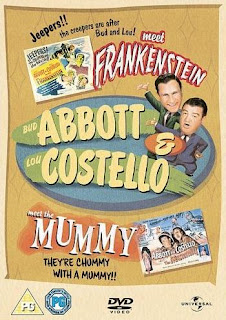















6 comments:
I loved this movie as a kid. However, I watched it again about a year ago and was sad to realize I didn't find it nearly as funny or scary as I did all those years ago (I suppose I shouldn't have been surprised).
I personally don't believe Abbott and Costello films are good vehicles for any of the old Universal monsters. I'm also not a fan of movies that throw as many monsters together as possible to enhance the thrill factor. As a kid, I loved seeing all the monsters together, but as I grew older I resented the cheapening of the characters that once gave me such great thrills.
It's a fun piece of nostalgia for me, but not much more.
Fair comments Mark. There is a question mark over the Monster Mash concept, but it is a formula that a lot of film companies used - there's even a rumour that Hammer looked at a Frankenstein/Dracula hybrid! But I respect, and fully understand, your position on such films.
To me the great thing about this film was Lugosi, seeing him in the roll again was wonderful.
It is, of course, the greatest film ever made. Glad you've enjoyed it!
cheers Chick
At last I readf a review that agrees with my opinion that this film is not utterly bad! I think it's entertaining and treats the monsters with respect as you said.
Universal had done so much monster-mixing by that time that this movie seems like a logical step for the studios. Hammer films, on the other hand, never really mixed the big 4 and it would've been terrible.
Also, in Hammer films Frankenstein is, as it should be, the doctor, not his creature. So a Dracula/Frankenstein film would've put Lee vs Cushing, but not as Van Helsing!
Curiously, Hammer did many more films with The Mummy (including the fantastic one with Lee and Cushing) than with the Wolfman (only one really). Universal, on the other han, was very generous in its use of the "monsters".
Hi The T, I do like this film.
I'm not sure exactly where Hammer would have gone with a monster mash, if they had followed that course, but, as you say, Universal really did like to mix their monsters together
Post a Comment